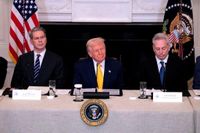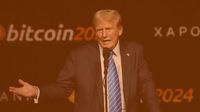In a significant shift in policy towards cryptocurrencies, U.S. President Donald Trump signed an executive order on March 6, 2025, aimed at establishing a "Strategic Bitcoin Reserve and a US Digital Asset Stockpile." Initially dismissing Bitcoin as a scam during his first term, Trump's recent actions signal a noteworthy embrace of digital assets, particularly Bitcoin, which is poised as a long-term strategic asset for bolstering American financial stability.
Bitcoin's value surged more than 3% on March 20, following Trump’s anticipated address at the Digital Asset Summit (DAS) in New York, where its trading price exceeded $86,000. This 7% increase over the past week reflects growing optimism around his administration's commitment to cryptocurrency. Joining Trump at the DAS were prominent figures including Michael Saylor from Strategy and BlackRock's Robbie Mitchnick, emphasizing the significance of this momentous event in the crypto world.
Since launching Bitcoin in 2009, the cryptocurrency landscape has evolved remarkably, with its proposed integration into U.S. fiscal strategy leading to widespread debates. The executive order states unequivocally that the Bitcoin deposited into the reserve is not intended for sale but instead to be maintained as a long-term asset. This pivotal move aligns with Trump’s vision of placing the U.S. at the forefront of digital currency innovation.
Trump's digital asset strategy stems from a dual objective: to devalue the dollar while maintaining its global dominance. As part of a broader economic vision, he seeks to boost U.S. exports through a cheaper dollar and enhance the government's borrowing power, a concept underpinned by tariffs that pressure foreign holders of dollars to invest in U.S. assets or offload their dollar holdings. An integral strategy in reversing the flow of dollars into the U.S. could involve persuading foreign governments and banks, particularly those like Japan that hold significant dollar reserves, to invest their dollars into cryptocurrencies.
Four days following the executive order, Trump endorsed stablecoins, a move that introduces a new avenue for dovetailing foreign currency reserves into the U.S. economic model. Stablecoins, such as Tether and USD Coin, function as dollar-backed cryptocurrencies and play a pivotal role in cross-border payments while adhering to the familiar stability of the dollar.
The strategy behind promoting stablecoins is vital. By incorporating them into the U.S. financial framework, the administration is effectively encouraging foreign investors to leverage their dollar holdings in stablecoins, thus increasing the dollar supply and ultimately facilitating a devaluation of the currency. This financial maneuvering could inadvertently heighten demand for U.S. Treasury securities as foreign actors seek to back up their stablecoins, fulfilling Trump's vision of reinforcing both the dollar's role and easing government debt servicing costs.
Despite the promising outlook, there are substantial risks involved. Historically, the global monetary ecosystem has been precarious, with previous reserves like the Gold Standard and Bretton Woods System collapsing under the strain of unsustainable practices. The reliance on private issuers of stablecoins could introduce significant vulnerabilities, with financial entities potentially issuing tokens without sufficient dollar backing, echoing past financial crises attributed to moral hazards.
As of late March 2025, the Federal Reserve maintained its benchmark rate steady at 4.25%-4.50%, signaling a cautious approach amid rising inflationary concerns. This pause follows three consecutive cuts at the end of 2024, reflecting the complex balancing act facing U.S. monetary policy as it integrates digital assets into the broader economy.
Trump’s comments at the DAS reinforced his administration's commitment, asserting: "It’s high time that our president started accumulating assets for the American people, which is what president Trump is doing rather than taking it away.” The urgency behind this strategic pivot to crypto as a sovereign asset is underlined by a significant cultural shift, with institutional participation in cryptocurrency reaching unprecedented levels.
Lastly, Bitcoin's current rise in value presents a curious juxtaposition against the backdrop of the U.S. dollar's historical prominence. Trump’s call to action reflects a transformational moment in how America perceives its economic future in an increasingly digital world. As financial institutions and governments worldwide take note, the establishment of a U.S. digital asset reserve could represent a new chapter in global finance, one that navigates the intricate dynamics of modern economics with a firm grasp on technological advancement.






